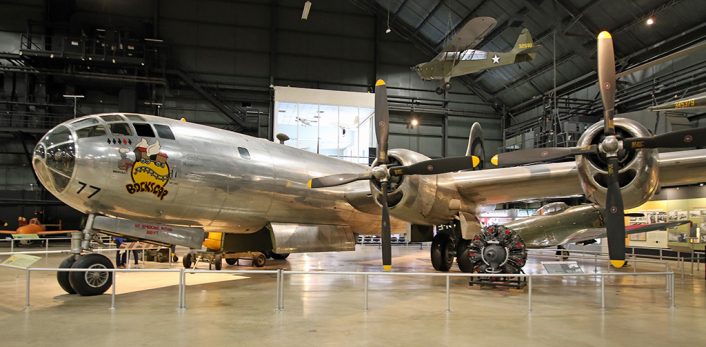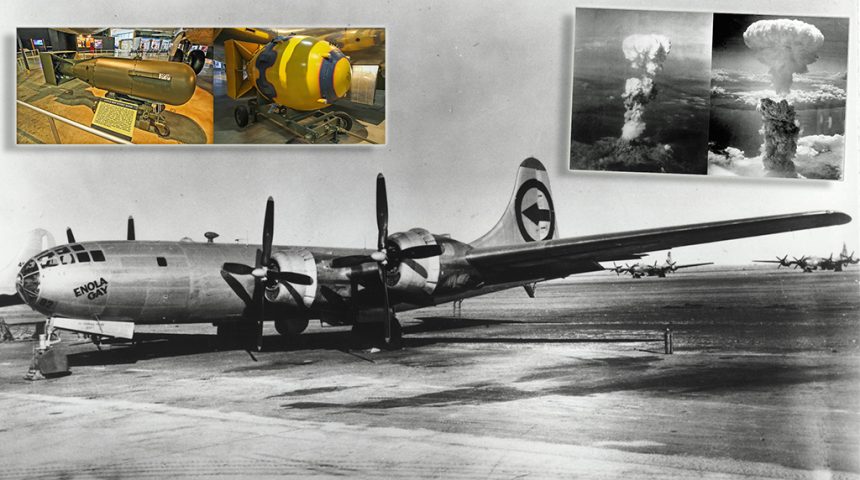Revisionist History and Pragmatic Calculus of The Hiroshima and Nagasaki Nuclear Strikes.
“It was as though the sun had fallen from the sky,” the man told me his father said about August 6, 1945 in Hiroshima. I told him that my father built the plane that dropped that bomb. There was a moment of silence between us. Then the man, Mr. Katsumi Shiji, looked at me and said, “I’m glad that you and I are here, together, today.”
In the years that have passed since history’s only operational nuclear strikes, the narrative of events that led up to them, and the inalterable change they exerted upon mankind, have been subject to the rigors of hindsight. Such is the privilege of time and perspective. But revisionist history has done a disservice to the truth about the U.S. nuclear strikes on Hiroshima and Nagasaki. And if there is a key lesson from the only two operational nuclear combat strikes in history, it is that we must examine history first through the eyes of those who lived it, not those who have the luxury of time to critique it.
While there is no diminishing the horror of the nuclear strikes on Hiroshima and Nagasaki, in the decades that have passed, the threat of immediate nuclear annihilation between superpowers has contracted significantly since the height of the Cold War. Prior to WWII, wars were a manifestation of destructive technologies of limited scale. While mankind could inflict vast suffering in conventional warfare, he lacked the ready ability to eliminate himself from the planet entirely. The development of nuclear weapons changed that. Humankind had, “acquired the means of its own destruction”.

(Photo: U.S. Air Force)
The terrible legacy of Hiroshima and Nagasaki vastly influenced the retreat from the brinkmanship of the Cold War. In Pulitzer Prize winning author Richard Rhodes’ comprehensive book, “The Making of the Atomic Bomb”, Rhodes writes, “The epidemic of manmade death collapsed abruptly after the second world war.” Rhodes’ thesis that the development and use of nuclear weapons has reduced global wartime fatalities is supported by statistics.
By 1943 the rate of human death from warfare had risen to 15 million people killed in wars per year. In fact, to this day the deadliest “weapon of mass destruction”, responsible for more human wartime fatalities than any other single weapons system- including nuclear weapons- remains the WWI Maxim machine gun. However, since the employment of two nuclear weapons in 1945 at the end of WWII, global war fatalities fell to an annual rate of 1.5 million deaths. As the post-WWII era gave way to the guerilla campaigns of the Cold War, the looming threat of nuclear annihilation drove proxy wars into third world and emerging regions like Africa, southeast Asia and the Middle East. The wars were still filled with horrors and atrocities, but the major population centers of the world like London, Tokyo, Berlin and Moscow were spared a second round of destruction. The images of Hiroshima and Nagasaki after the nuclear strikes were a prominent reason.
The two nuclear strikes, Hiroshima on August 6, 1945 and Nagasaki on August 9, 1945, while both highly effective from a military perspective, were vastly different in execution. The strike on Hiroshima went almost exactly according to plan, arriving over Hiroshima, the mission’s primary target, only 17 seconds behind schedule in fair weather. The strike on Nagasaki courted disaster from its very onset.
Perhaps the first foreboding thing about the second nuclear strike was that the Japanese knew it was coming. It was only a matter of where and when.
The target for the second nuclear strike was the Japanese military-industrial city of Kokura. In the predawn darkness of Thursday, August 9, 1945, Chaplain Downey at the 509th Composite Group delivered a prayer to the crew of “Bock’s Car”, the Boeing B-29-36-MO Silverplate bomber specially built as a nuclear attack aircraft. Downey beseeched the Lord that, “Above all else, Our Lord, bring peace to this world”. It was at that moment that it seemed the devil and God Himself battled in waves of misfortune and incredible luck for the destiny of man through the crew of Bock’s Car.

Before Bock’s Car even left the ground, a fuel system malfunction meant that 600 gallons of gas trapped in a rear tank could not be accessed due to an electrical problem. This meant the aircraft would fly the mission with 6,400 gallons of aviation fuel, not the planned 7,000 gallons. This first problem would magnify into more problems, nearly altering the destiny of human history.
The second nuclear strike mission on Kokura would be flown with a different nuclear weapon than the Hiroshima bomb. The Mark III, Combat unit F-31, Model Y 1561, named “Fat Man” was a 10,300-pound weapon that was significantly more powerful than the “Little Boy” weapon used at Hiroshima three days earlier. The construction and fusing of Fat Man meant that the weapon would be armed when Maj. Charles W. Sweeney and his crew took off, different from Little Boy, that was armed in air. Sweeney was concerned that, “If we crashed on takeoff, we could obliterate the island”.

(Photo: TheAviationist/Tom Demerly)
Weather plagued the second nuclear strike mission. Turbulence caused the already under-fueled Bock’s Car to have to climb to 17,000 feet, requiring more fuel than originally planned, even though the crew took off with access to less fuel, but with the weight of a full fuel load.
Despite the fuel and weather problems the next four hours passed somewhat according to plan. Suddenly, a series of red lights on instrumentation indicated that several of Fat Man’s arming circuits were now live. The diagnostics did not differentiate between the circuits that were altitude triggered or time triggered. If the circuits were time triggered, Fat Man would detonate in 43 seconds. Crewman Phil Barnes managed to fix the problem before the time limit expired.
Sweeney’s crew in Bock’s Car was supposed to rendezvous with Lt. Col. James Hopkins B-29 observation aircraft en route to Kokura, but Hopkins was not at the rendezvous point. Sweeney orbited in the rendezvous area for nearly an hour, contributing to the already escalating fuel crisis. Hopkins’s B-29 never did appear for the rendezvous.
With fuel problems escalating, Bock’s Car arrived on target over Kokura to find it was obscured by clouds, defended by heavy flak and at least ten Japanese Zeroes. It couldn’t have been more different than Col. Paul Tibbets’ strike on Hiroshima.
With fuel critically low in Bock’s Car, and the primary target, Kokura, nearly impossible to attack accurately, Maj. Sweeney and his crew diverted to their secondary target, the city of Nagasaki. They may have enough fuel for one attack run on the target, if it were not obscured by clouds, or heavily defended by anti-aircraft guns and Japanese fighters. Sweeney’s crew did have the capability to bomb by radar, but the overwhelming priority was to bomb visually, both for accuracy and for bomb damage assessment.
With their fuel emergency worsening and a safe return to their home base of Tinian now impossible, Sweeney and his crew felt they may make the emergency landing area at Okinawa, a place where lost, damaged and fuel-starved B-29s could make an unplanned diversion.
As Bock’s Car approached Nagasaki, the city lay concealed under an 80% blanket of cloud cover. Sweeny agonized over bombing by radar, eventually understanding it was his only alternative. Trying to fly the nuclear armed B-29 back to a friendly base, even the emergency base at Okinawa, was impossible due to the extra weight of the bomb. Descending below the bomb’s air burst detonation altitude of 1,910-feet risked the bomb going off. Losing the bomb at sea was not an option. Bock’s Car had to drop Fat Man, and Nagasaki would be the place.
As Sweeney and his crew began their bomb run they showed approximately 300 gallons of fuel remaining. If they bombed on their first run over Nagasaki, executed their anti-blast clearing turn and flew directly to Okinawa, there remained a distant chance they may make it home. If not, they would ditch in the Pacific and hope for rescue. Just as the crew began their radar-guided bomb run an opening in the clouds appeared, and the fate of approximately 80,000 Japanese in Nagasaki was sealed. Bock’s Car transitioned to visual bombing and delivered Fat Man accurately on target at 11:01 local time.
On the return trip Sweeney’s crew used a fuel conservation technique called “flying on-step”, a series of gradual descents from altitude that enables the aircraft to effectively “coast” downward through several cruise altitudes, extending its horizontal range.
With only seconds to spare, the crew of Bock’s Car spots Okinawa, just as their first of four engines dies from fuel starvation. Sweeney continues his one-chance landing approach on three engines. Only seconds after he touches down on the threshold of Okinawa, a second engine runs out of fuel and stops. As the giant bomber rolls out at the end of the runway, a third engine quits, out of gas. By the time Bock’s Car rolls to a stop, she has 7 gallons of fuel left, enough for less than 60 seconds. The mission had taken 20 hours since takeoff.
As Hiroshima and the world marks the 75th year since the first nuclear strike, the debate over the morality of the U.S. nuclear strikes on Japan continues. Just as nuclear weapons technology and proliferation have made the world a more dangerous place since August 6, 1945, the moral and academic reexamination of the nuclear strikes on Hiroshima and Nagasaki have made it safer, with a broader global repulsion to the use of weapons of mass destruction by nations despite their growth in availability. It is this balance of intellectual retrospective and threat of annihilation that continue to maintain this frail balance of peace from nuclear war. So far.










